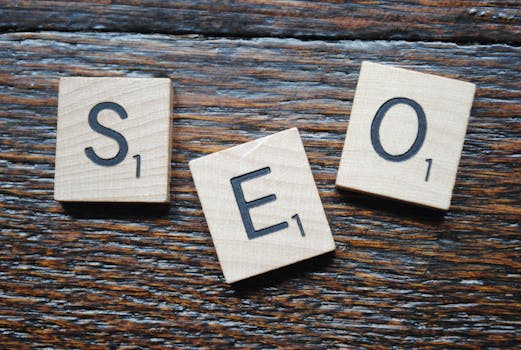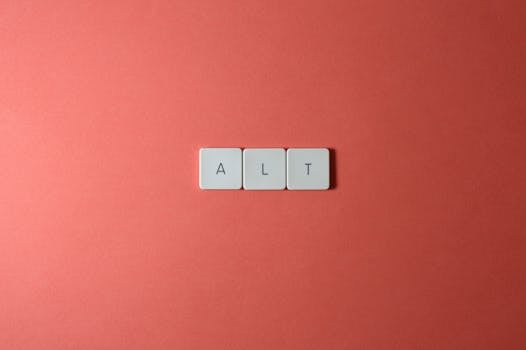Alt Text Tips for E-Commerce and Product Images
Common Mistakes to Avoid When Writing Alt Text
Avoid these common pitfalls when crafting alt text for your e-commerce images to ensure accessibility and SEO effectiveness.
- Don’t just say ‘image of.’ Be specific about what the image shows.
- Avoid keyword stuffing. It makes your alt text sound robotic and unhelpful.
- Skip vague descriptions. Instead of ‘shoe,’ say ‘pair of blue running shoes with white laces.’
- Don’t forget context. Mention the setting or usage, like ‘red dress on a mannequin in a boutique.’
- Avoid redundancy. Saying ‘image of’ is unnecessary; just describe the image directly.
- Don’t ignore accessibility. Alt text is crucial for visually impaired users relying on screen readers.
- Avoid overly long descriptions. Keep it concise; aim for clarity and brevity.
- Neglecting SEO potential is a mistake. Well-crafted alt text can boost your search visibility.
Alternative Approaches to Alt Text Creation
Most people think that alt text should focus solely on keywords for SEO. I believe a user-first approach is far more effective. Instead of stuffing keywords, we should aim for clarity and descriptiveness. This enriches the experience for all users, especially those with visual impairments.
Take, for instance, the idea of integrating visual context. Rather than just saying ‘blue shirt’, why not describe it as ‘a blue shirt hanging on a vintage wooden hanger’? This paints a fuller picture for both users and search engines.
According to Nikoleta Kokleviciute from TinyIMG, “Well-written alt text not only enhances the user experience but also significantly contributes to SEO by providing context for images.” This perspective highlights the importance of context over keyword density.
Another angle to consider is the role of digital accessibility training. Companies should embed this training into their culture. It empowers employees to create content that adheres to best practices, including effective alt text usage. This proactive approach can boost brand loyalty and reputation.
Incorporating AI tools for alt text generation is another exciting trend. Many believe automation can compromise quality. But I think it can save time and maintain consistency, especially for businesses with large image libraries.
So, while the traditional views on alt text have their merits, there are innovative approaches that can enhance both accessibility and SEO. It’s time we rethink how we craft alt text.
… digital products meet the Revised 508 Standards. The profound impact of … Tag decorative images with a blank alt tag. alt=”” <img src=”decorative_1 …
Guide to Accessible Web Design & Development | Section508.gov
Mar 18, 2022 … Lack of text alternatives (“alt text”) on images. People who are … product that was inaccessible to a blind student. Title III Sample …
Home page of the United States Patent and Trademark Office's main web site.
We support America's small businesses. The SBA connects entrepreneurs with lenders and funding to help them plan, start and grow their business.
How Alt Text Affects Image Search Rankings
Here are some impactful tips for optimizing alt text to boost your e-commerce image search rankings.
- Descriptive alt text is a must! It helps search engines understand your images better.
- Keep it concise. Aim for clarity without overstuffing keywords.
- Use relevant keywords naturally. This can improve your chances of appearing in image searches.
- Avoid generic phrases like ‘image of.’ Instead, describe what’s in the image.
- Consider the context. Including details about how a product is used can enrich the alt text.
- Think about accessibility. Well-crafted alt text benefits visually impaired users and boosts SEO.
- Use tools for consistency. AI tools can help generate alt text efficiently, ensuring you don’t miss images.
- Stay updated! Search algorithms change, so keep refining your alt text strategies.
- Test and analyze results. Monitor your image search rankings to see what works best.
- Don’t forget legal compliance. Proper alt text can help you avoid potential lawsuits.
Best Practices for Crafting Alt Text
Writing effective alt text is more than just a checkbox task. It’s about making images accessible and improving SEO. Concise and descriptive alt text can elevate user experience.
Most people think that alt text should just be a straightforward description of the image. I believe it should tell a story, too. For example, instead of saying ‘blue shirt,’ try ‘light blue cotton shirt displayed on a wooden hanger.’ This gives context.
Many experts advocate for keyword optimization. But I think focusing solely on keywords can feel forced. A natural, informative tone engages users better. According to Nikoleta Kokleviciute from TinyIMG, “Well-written alt text not only enhances the user experience but also significantly contributes to SEO.”
Some suggest avoiding phrases like ‘image of.’ I totally agree! Just get straight to the point. Instead of saying ‘image of a red dress,’ say ‘red evening dress with intricate lace detailing.’ It’s more engaging.
Another approach is to incorporate the setting or usage into your alt text. For instance, instead of ‘sneakers,’ go for ‘blue sneakers on a gym floor.’ This paints a clearer picture for everyone.
Looking ahead, using AI tools for alt text generation can be a lifesaver. Automating this process can save time and ensure consistency across your product images. It’s a smart move for busy e-commerce stores.
In conclusion, crafting alt text is an art. It’s about balance—being descriptive yet concise. Let your alt text reflect the essence of your images while boosting accessibility and SEO.
Apr 5, 2022 … No alt text provided for this image. Use lifestyle product images to help potential customers imagine enjoying your product and to show that …
A Guide To Ecommerce Product Images (+ 10 Tactics To Improve …
Jun 24, 2021 … And that number is only expected to keep rising… No alt text provided for this image … 11+ E–Commerce Copywriting Tips That Increase …
How To Write Product Descriptions That Don’t Suck (Copywriting …
Future Trends: AI Tools for Alt Text Generation
Most people think writing alt text is a manual task. I think that AI tools can transform this process. Imagine automating alt text generation while maintaining quality!
AI can analyze images and produce descriptive text in seconds. It’s that simple. This not only saves time but ensures consistency across your product images.
Some experts argue that AI lacks the nuance of human creativity. But I believe AI can complement our efforts. With the right training, these tools can learn to generate contextually relevant alt text.
As noted by Nikoleta Kokleviciute from TinyIMG, “Well-written alt text not only enhances the user experience but also significantly contributes to SEO.” Imagine having AI handle this while you focus on strategy!
Integrating AI tools into your workflow can streamline alt text creation. This is especially beneficial for e-commerce platforms with vast image libraries. Why struggle with repetitive tasks when AI can do it for you?
Additionally, using AI can help identify gaps in your current alt text. It can suggest improvements based on best practices. This proactive approach can boost your SEO efforts.
Incorporating AI into alt text generation is not just a trend; it’s a necessity. As e-commerce continues to evolve, embracing these technologies will keep you ahead of the competition.
Mar 2, 2021 … FAQ : How long should Alt text be for images? Your Alt text should contain 10 to 12 words maximum. We recommend including your brand name if …
Jan 8, 2023 … How should I go about alt text for product images? Help – alt text help … e–commerce stores, but I could have been told incorrectly. Upvote 1
Alt text should not just describe the image, but provide context on how the image relates to the page content. Alt Text Best Practices. Keep it short, usually 1 …
Write helpful Alt Text to describe images | Digital Accessibility
… tips-for-your … Hi, I noticed posts dating to 2016 about Weebly not allowing us to add Alt–Text or Alt–Tag to Product Images on E–Commerce websites.
Legal Considerations for Alt Text in E-Commerce
Ignoring alt text isn’t just a missed opportunity for SEO; it can lead to serious legal trouble. The Americans with Disabilities Act (ADA) requires that all website content, including images, be accessible to those with disabilities. Without proper alt text, businesses risk lawsuits and penalties that can damage their reputation and finances.
Most people think compliance is merely a checkbox to tick off, but I believe it should go beyond that. It’s about creating an inclusive environment that values all users. Companies should actively promote accessibility as part of their core values, not just as a legal obligation.
According to Holly Cardew from Pixc, “Not only is adding alt text important for search visibility, but it’s increasingly critical for compliance with legal standards.” This highlights that alt text is not just a technical requirement; it’s a commitment to inclusivity.
Legal cases around accessibility are on the rise. Businesses need to prioritize alt text to avoid these issues. It’s a straightforward way to demonstrate a commitment to inclusivity. As the Bureau of Internet Accessibility states, “Web accessibility is not just a legal requirement; it’s about acknowledging and valuing the diverse needs of users.” This perspective shifts the focus from compliance to genuine concern for user experience.
Training employees on digital accessibility can empower them to create content that meets legal standards. This proactive approach can significantly reduce legal risks. Plus, it enhances the overall user experience, making your e-commerce platform more welcoming.
The Role of Alt Text in Accessibility and SEO
Here are some key insights and tips for optimizing alt text in e-commerce:
Importance of Alt Text for E-Commerce
Alt text is a game changer for e-commerce. It boosts accessibility and SEO simultaneously. Without it, visually impaired users can’t understand images. That’s not just a missed opportunity; it’s a big no-no in today’s digital world.
Many people think alt text is just about keywords. But I believe it should prioritize clarity and user experience. Instead of stuffing keywords, focus on what the image conveys. For example, instead of “image of a blue shirt,” say “blue cotton shirt with short sleeves—perfect for summer outings.” This approach enhances the shopping experience.
Legal compliance is another big reason to use alt text. Neglecting it can lead to lawsuits. The Americans with Disabilities Act (ADA) requires websites to be accessible. Failing to provide adequate alt text could put your business at risk.
Most experts say to optimize for search engines. But I think it’s just as important to think about the user. Alt text should be informative and engaging. It’s not just a checkbox; it’s a chance to connect with your audience.
One innovative idea is using AI tools for generating alt text. Automating this process can save time and ensure consistency across your product images. Imagine having a tool that creates descriptive alt text for thousands of images! This could revolutionize how e-commerce businesses manage their visual content.
In summary, alt text is more than a technical requirement. It’s a vital part of your e-commerce strategy that can enhance user experience, improve SEO, and protect your business legally. Don’t overlook it!
What is alt text and why is it important?
Alt text, or alternative text, is a description of an image. It’s crucial for accessibility, especially for visually impaired users relying on screen readers. Without it, these users miss out on important content.
It’s not just about accessibility; alt text plays a big role in SEO. Search engines use it to understand and index images. This can improve your site’s visibility and drive organic traffic.
Many think that stuffing keywords into alt text is the best approach. But I believe that clarity should come first. A natural description enhances user experience and makes your content more relatable.
As Nikoleta Kokleviciute from TinyIMG says, “Well-written alt text not only enhances the user experience but also significantly contributes to SEO by providing context for images.”
Incorporating alt text shows commitment to inclusivity and can help avoid legal issues. As Holly Cardew of Pixc notes, “Not only is adding alt text important for search visibility, but it’s increasingly critical for compliance with legal standards.”
Think of alt text as your chance to connect with users. It’s a simple way to make your site more accessible and SEO-friendly.
How can I write effective alt text for product images?
Writing effective alt text is simpler than you think! Start with clarity. Describe what’s in the image. Instead of saying ‘image of shoes,’ say ‘pair of red running shoes with white soles.’
Be specific. Mention the details that matter. For example, ‘red evening dress laid out on a wooden bench’ paints a better picture than just ‘red dress.’
Most people focus on keyword stuffing, but I think it’s better to prioritize natural language. It makes the alt text more user-friendly and engaging.
Using AI tools for alt text generation is gaining traction. These tools can save time and maintain consistency across your images. But don’t forget to review them for accuracy!
According to Nikoleta Kokleviciute from TinyIMG, ‘Well-written alt text not only enhances the user experience but also significantly contributes to SEO.’ That’s a win-win!
Remember, alt text is not just a box to check off. It’s about creating a better experience for everyone, especially those relying on screen readers.
Can AI tools help in creating alt text?
Many people think AI tools can simplify alt text creation. But I believe they can miss the mark. Automated systems often lack the nuance that human writers bring.
For instance, AI might generate generic descriptions. It won’t capture the essence of a product like a human can. According to Nikoleta Kokleviciute from TinyIMG, ‘Well-written alt text not only enhances the user experience but also significantly contributes to SEO.’
Instead of relying solely on AI, combine its efficiency with human insight. This hybrid approach can yield the best results. After all, understanding context and emotion is something AI struggles with.
Plus, leveraging AI for initial drafts can save time. Then, tweak those drafts to add the personal touch. This way, you get the best of both worlds!
What are the legal implications of not using alt text?
Neglecting alt text can lead to serious legal troubles. Companies may face lawsuits for not complying with the Americans with Disabilities Act (ADA). This means that without proper alt text, you risk excluding individuals with visual impairments from accessing your content.
Many believe that simply adding alt text is enough for compliance. But I argue that it’s not just about legality; it’s about inclusivity and commitment to all users. As Holly Cardew from Pixc states, “Not only is adding alt text important for search visibility, but it’s increasingly critical for compliance with legal standards.”
Ignoring alt text can damage your brand’s reputation. It shows a lack of care for user experience. Instead of seeing accessibility as a chore, why not embrace it as a chance to build loyalty? According to the Bureau of Internet Accessibility, “Web accessibility is not just a legal requirement; it’s about acknowledging and valuing the diverse needs of users.”
Some argue that focusing solely on legal compliance is limiting. I believe businesses should adopt a proactive approach. This means embedding inclusivity into their brand ethos, promoting it through marketing and training. This forward-thinking can enhance your brand reputation and foster customer loyalty.
Most people think that writing alt text manually is the only way. I believe using AI tools can streamline this process significantly. It’s that simple! Automation not only saves time but also guarantees consistency across your product images.
Some experts argue that automated alt text lacks creativity. But I think AI can produce solid descriptions when trained properly. According to Nikoleta Kokleviciute from TinyIMG, “Well-written alt text not only enhances the user experience but also significantly contributes to SEO.”
Imagine having an extensive image library without the manual hassle. That’s the power of AI! Embracing this technology can elevate your e-commerce game.
Most people think adding alt text is just a good practice. I believe it’s a legal necessity because neglecting it can lead to lawsuits. According to Holly Cardew from Pixc, ‘Not only is adding alt text important for search visibility, but it’s increasingly critical for compliance with legal standards.’
Ignoring alt text isn’t just risky; it’s a missed opportunity for inclusivity. Businesses should embed accessibility into their brand ethos, not treat it as a checklist.
Training employees on digital accessibility can be a game-changer. It ensures everyone understands the importance of alt text and how it impacts user experience.
Alt text is a game changer for visually impaired users. It provides essential context for images. Without it, they miss out on product details that others see. Accessibility is not just a checkbox; it’s a necessity.
Most experts say to focus on keyword optimization in alt text. But I believe clarity should come first. Descriptive alt text enriches the shopping experience for everyone.
Let’s not forget the legal side. Neglecting alt text can lead to lawsuits. Being inclusive isn’t just good practice; it’s the law!
As we move forward, integrating AI for alt text generation can save time. It ensures consistency and quality across your image library.
According to Holly Cardew from Pixc, “Not only is adding alt text important for search visibility, but it’s increasingly critical for compliance with legal standards.” This shows that alt text is not just a technical detail; it’s a fundamental part of your e-commerce strategy. Make it a priority!
Most people think alt text should be keyword-heavy. I believe it should focus on the user experience instead. Descriptive alt text enhances understanding and enjoyment for all shoppers.
For example, instead of saying ‘blue shirt’, try ‘light blue cotton shirt perfect for summer outings.’ This paints a clearer picture.
According to Holly Cardew from Pixc, “Images without alt text can not only hamper accessibility but also detract from potential search engine visibility.” So, let’s make it count!
Plus, integrating visual context can be a game changer. Instead of just stating what’s in the image, describe how it’s used or where it’s found. This approach adds depth and relatability.
And don’t forget about the future! With AI tools on the rise, automating alt text generation can maintain consistency and save time. But keep the user in mind; automation shouldn’t sacrifice quality.
Most people think that alt text is just for accessibility. I think it’s a game changer for SEO too! It’s that simple: well-crafted alt text boosts your image search rankings.
Images without alt text? They’re like a shop without a sign. According to Holly Cardew from Pixc, “Images without alt text can not only hamper accessibility but also detract from potential search engine visibility.”
Some experts suggest focusing on keywords in alt text. But I believe integrating product context is more beneficial. A description like ‘red evening dress on a wooden bench’ paints a vivid picture for users and search engines alike.
Looking ahead, using AI tools for alt text generation could save time and ensure consistency. Imagine automating this process for a huge catalog! It’s a win-win for efficiency and quality.
Let’s not forget the legal side. Proper alt text can help avoid lawsuits and demonstrate commitment to inclusivity. As the Bureau of Internet Accessibility states, “Web accessibility is not just a legal requirement; it’s about acknowledging and valuing the diverse needs of users.”

Albert Mora is an internationally renowned expert in SEO and online marketing, whose visionary leadership has been instrumental in positioning Seolution as a leader in the industry.










